65 Indonesia from Papua New Guinea 1997
Indonesia from Papua New Guinea 1997
By Rick Bein and lovingly edited, by Alex Bein, Maryellen Bein, Jeanie Bein and Candy Riggins, January 1998
I took vacation leave from my post at the Papua New Guinea University of Technology (UNITECH) in Lae in mid-December 1997. My spouse (Maryellen) and I, two teenage daughters (Molly and Kristen) and two adult children (Candy and Christopher) joined us from the States to make the two-week journey to Indonesia.
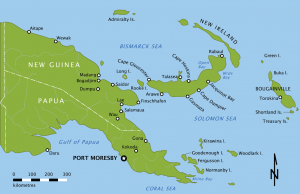 Papua New Guinea.png by spoolwippets is marked with CCO 1.0. Jaia Pura State in Indonesia borders on the left of the map.
Papua New Guinea.png by spoolwippets is marked with CCO 1.0. Jaia Pura State in Indonesia borders on the left of the map.
We left Lae, Papua New Guinea early Tuesday 16 December 1997 for Vanimo, Papua New Guinea from where we arranged to travel on to Indonesia. After a short stop in Madang, we experienced spectacular views as the plane flew past a smoking volcano, over the meandering Ramu and Sepic Rivers and their silt plumes that extended far out to sea.
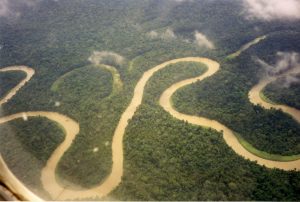 Meandering Sepic River: Photo by Rick Bein 1998.
Meandering Sepic River: Photo by Rick Bein 1998.
We had a four-hour layover in Wewak because of plane delays. There we enjoyed a few hours resting and collecting shells on the beach outside the Sandaun Motel across the street from the Airport. There we enjoyed a few hours resting and collecting shells.
 Molly, Candy and Christopher Beckman with stick retriever on Beach at Wewak. Photo by Rick Bein 1998.
Molly, Candy and Christopher Beckman with stick retriever on Beach at Wewak. Photo by Rick Bein 1998.
Christopher befriended one of the local dogs who loved to chase anything thrown into the sea. He almost boarded the plane with us when we left for Vanimo.
Once in Vanimo we discovered that there were no hotel rooms available since there were two simultaneous conferences being held when we arrived. Lucky for us Philip Tjoeng, a stranger to us, and owner of Vanair Airlines and several shops in Vanimo, happened to be at the airport. This angel quickly saw our predicament and as naturally as if we had been his own family offered us his home. We stayed two nights with our wonderful host whom we enjoyed very much and who even lent us his private vehicle to drive over to the Irian Jaya border. Bernard Marahau, brother of Guli in the Mining Engineering Department at Unitech, took a
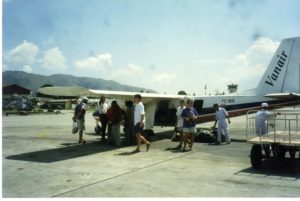 Departing Vanimo for Indonesia Photo by Rick Bein 1998.
Departing Vanimo for Indonesia Photo by Rick Bein 1998.
Map of Indonesia, 2011″ by nathanh100 is free licensed under CC BY 2.0
half day off work and accompanied us along this coast road. We enjoyed swimming in the surf not far from Vanimo.
On Wednesday we dealt with the issue of getting over to Indonesia which involved acquiring a visa from the Indonesian consulate, an exit stamp for the PNG and booking passage over to Jaya Pura. The first two were routine, but we found out that it was not possible to travel by water over to Jaya Pura as planned. A recent Indonesian change in policy prohibits travelers from PNG from arriving in Irian Jaya by surface travel, so we needed to charter a small plane. As it turned out we were able to fill up the plane with additional passengers which reduced our cost considerably!
On Thursday, the 18th we arrived in Jaya Pura where we encountered a completely different place from Vanimo, or, for that matter, anywhere else in PNG. Javanese dominate the city of Jaya Pura, subjugating the Papuan (Melanesian) people. Although I had heard of the Papuan resistance, there was no evidence in Jaya Pura.
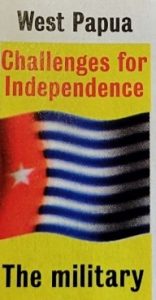
West Papuan resistance banner and flag contribute to a consolidated resistance confined to the hills in the interior of the island. Their weaponry is hardly a match to that of the Indonesian machine guns and armor. Image from the New Internationalist, volume 344, April 2002.
Coming from the airport at Santani we passed many Melanesian communities and noticed one where the people make their livelihood from their stilt houses over the water along the thirty-kilometer Lake Santani.
 Approaching Jaya Pura: Photo by Candy Beckman 1998.
Approaching Jaya Pura: Photo by Candy Beckman 1998.
Jaya Pura is very much like other Indonesian towns but is tightly compacted into a valley leading down to the harbor. Four and five story buildings are common, and people can walk to complete most of their transactions. Automobile traffic is congested, and a one-way street circles the business section of town to reduce the problem. Having a good horn is probably one of the priorities for registering a vehicle. A large, seemingly chaotic, ramshackle market extends for blocks on the western side of an extremely polluted stream that empties into the harbor. There are many buildings under construction and filth and dust seem to prevail. The streets are full of leering young men and teenage boys who seem to have no compunction about how and when they address the young women in our family. The women in our group become very distrustful of the Malay Indonesians from Java because of this harassment.
 Our boarding Pass
Our boarding Pass
Our main mission in Jaya Pura was to book passage on the Dobonsolo passenger ship and once completing that we could take in some of the sights. We found that the Pelni office in Jaya Pura had just opened a new office several kilometers out of town on the way back to the airport and the hotel personnel discouraged us from going there to purchase our tickets because of the crowds, the heat and the time. They suggested that we hand over our money to a travel agent who would purchase our tickets. I chose to do this despite my family’s doubts about the good intentions of the travel agent. With some apprehension we spent Friday morning worrying that the agent had run off with our money while we could have spent the time site seeing. Around 1 PM the agent appeared with our tickets. We did make it to the bank and for $1500 we purchased an ungodly amount of paper money.
The American Dollar was worth about 5,000 Rupiahs and huge bundles of paper notes were necessary every time a purchase was made.
The cost of everything was quite low in Indonesia at that time; half the price of what it would cost in the United States and two-thirds of that in Papua New Guinea. Inflation was a serious problem in Indonesia in the previous few months as it was caught up in the Southeast Asia monetary decline. Each day the Rupiah would drop a few points and over the two-week period the Dollar changed from 4900 to 5200 Rupiahs.
Although boarding began at 1 PM, we were advised to board the Dobonsolo at about 3 PM to avoid the earlier rush of the 4th and 5th class passengers who needed to scramble to claim sleeping places on the lower decks. We began boarding at 2 PM and as predicted were caught up in the rush of early boarders.
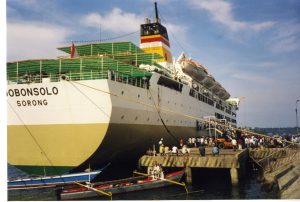
Boarding the Dobonsolo Photo by Candy Riggins 1998.
This turned out to be like running a gauntlet for the women in our group who had their hands full of baggage and could not easily defend themselves from the probing hands of the young men in our midst as the crowd surged up the gang plank.
The Dobonsolo was a glorious ship designed to move hundreds of passengers at a time. It was a “new” ship built to carry out the trans-migration of Javanese to the distant areas of Indonesia including Irian Jaya. She was I exceptionally clean and well kept. We found our first-class cabin on the 6th deck while the four offspring occupied a second-class cabin across the hall. Both classes were clean and had their own private shower and toilet. In contrast to second class the first class had a television, a porthole toward the sea and no upper bunk. All passengers received three meals per day, but the different classes of passengers ate in separate parts of the dining room. We would walk over and see how our kids were doing with the strictly Indonesian food. Although not always in the best of humor about the food, they did receive a great experience in cultural cuisine.
Little English was spoken aboard the Dobonsolo. Some of the crew knew a few words of English and on a few occasions, expatriates traveling from one port to the next could explain some things we did not understand. One other American family, who was translating the Bible into one of the local languages, was helpful, but they only rode the Dobonsolo to the second port stop. The loudspeakers throughout the ship inside our cabins were full of announcements day and night of which we understood extraordinarily little. The Islamic prayers came on five times a day and one time an abandon ship drill was announced and despite our ignorance we began to worry about all the alarms and people running around. When Chris noticed that the alarm matched the Morse code signal to abandon ship, I decided to have a look around. On the next deck level, I found some of the crew demonstrating to a group of passengers how to inflate life jackets and how to proceed to the lifeboats.
I am sure we missed some of the on-board events, but we never missed any meals because the crew would make special trips to come knock on our cabin doors to make hand gestures toward their mouths when it was mealtime. We began learning a few basic words in Bahasa Indonesia, but little by little the crew began learning a few more words of English and by the time we reached Bali they all understood “toilet paper”!

“Squat toilet” by Goldberg is licensed under CC BY 2.0
Many Indonesians do not use toilet paper and their toilets are equipped with a small water hose to wash their extremities with the left hand (an environmentally friendly practice as long as one washes their hand afterwards). We must have greatly depleted their stock of toilet paper because after the third day when we asked, they would only give us one roll to share among the six of us rather than two per cabin. This became a major concern for those in our family whose stomachs were having difficulty adapting to the Indonesian food.
Indonesian food is indeed spicy, and dishes were made with great care and love that was not always appreciated by our group. We usually did not know from what the dishes were made. Tough, over cooked slices of water buffalo reminded us of shoe leather while the eyes of the fish still watching from the dinner plate were too much for some of us. The procedure for discovering what the different menus contained was quite interesting as the waiters found themselves compelled to exclaim “moo” or to pantomime. This became rather entertaining for the crew and the other guests in the dining room. We were not subtle passengers, but we did make friends with most of the crew.
The four women of our family were all vegetarians and since there was no choice from the food that was served, finding something they would eat was difficult and I must say everyone but me lost weight while aboard ship. I must admit, I enjoyed the local cuisine and did not always need to know exactly what I was eating.
Five days on board ship seemed a long time. Exploring the ship was one activity, and we found a front upper deck on the eighth level which was reserved for the exclusive use of the Captain and immediate crew, but because they hardly ever used it, they allowed us to enjoy the privacy it offered. Among the great panoramas we watched harbor dockings, the loading and unloading of cargo, the land and sea go by, and the occasional dolphins. Once we saw a small whale. The stars at night were fabulous from this vantage point. It was also a great place for our sun lovers.
The Dobonsolo stopped at five ports on our way to Bali. Those were Biak, Manokwari, Sorong, Ambon, and Kupang. They allowed us to disembark and spend a couple of hours at each port. At Biak (3 hours) we found a grocery store, in Manokwari (2 hours) we visited a World War II museum, at Sorong (5 hours) we went to a small beach, at Ambon (5 hours) we went for a taxi ride through what looked like a real city with mosques, large buildings and found a nice looking museum which we had no time to visit, and at Kupang we found an art shop, a cottage industry where they made embroidered textiles and a restaurant that served cold beer. At each stop we bought ten inches long freshly picked mangos and brought them on board for snacks….it was fun watching Chris peel and eat them like a banana.
 Jaya Pura from the air, Indonesia. Photo by Candy Riggins 1998.
Jaya Pura from the air, Indonesia. Photo by Candy Riggins 1998.
We rode in taxis at each of the port visits but found them designed for short people and not for large touring Americans. While we were already crowded in our seats our heads extended well above the top of the windows and we could see little of the sights. Just outside each port were impromptu markets where vendors sold beadle nut, soft drinks, bottled water and fresh fruits to the transient passengers. Time was too short to properly explore each of these places, but we were able to gather some more of the diverse flavor of Indonesia as we went along.
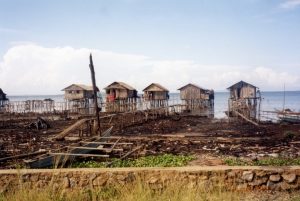 Houses over the Sea, Sarong, Indonesia. Photo by Candy Riggins 1998.
Houses over the Sea, Sarong, Indonesia. Photo by Candy Riggins 1998.
We found the Indonesians in these port towns to be very curious people. I carried the Lonely Planet Guidebook and would look up references to places that we were trying to find. At times I would stop to ask questions and would point out the reference to a taxi driver or shop keeper. Immediately any other nearby bystander would suddenly be hovering over me to see what I had in the book. I felt annoyed by this and would deliberately turn my back to the intruder. He would then bob, weave and stretch around my hulking body trying to see the pages and I in turn would subtly move a shoulder, arm or head to block his view. Later I found out that all this maneuvering created a rather amusing side show for my family and some of the other bystanders.
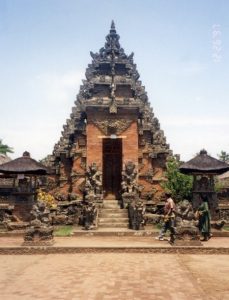
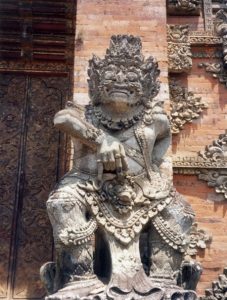

Above photos of Bali by Candy Riggins 1998 :Balinese temple, Icon and dance.
Mid afternoon on Wednesday 24 December the Port of Benoa, Bali was a welcome site. We decided to avoid the most touristic part of Bali around Kuta Beach and go over to Sanur Beach just southeast of Denpasar, the capital. Using the “Lonely Planet Guidebook” we located on the second try, the Gazebo (pronounced “guezebow!”), a reasonably priced hotel with adequate facilities that suited a group of selective Americans. This was where we spent Christmas and four days exploring South Bali. Free Map of the Island of Bali in Indonesia 2011 Creative Commons Attribution Non-Derivative License (CC BY-ND).
Free Map of the Island of Bali in Indonesia 2011 Creative Commons Attribution Non-Derivative License (CC BY-ND).
Sanur was still touristic (as is all of Bali, I hear) but it was quiet compared to the highly developed Kuta. It seems that Bali was geared to tourism and everyone was constantly trying to sell something. Vendors were constantly showing us some item to buy whether we needed it or not. We found that if we were polite and spoke to the venders, it was considered an attempt on our part to begin negotiating a purchase. “No” was not a suitable answer either and ignoring the person from the beginning saved lots of time. Once we showed some interest in an item, a vendor would immediately begin discussing price and would ask something two or three times higher than what he or she had hoped to sell it. Often a vendor was so intent on consummating a sale he would negotiate below his own breakeven point. After a while we learned the process and were able to make some good purchases.
One of the reasons for traveling to Indonesia and in particularly Bali was to shop for shoes, clothes, and other personal items not available in PNG. In Denpansar and Kuta large shopping malls offered worldly goods for reasonable prices. The stores fixed these prices and allowed no negotiating. Also in the malls were fast food places like Mc Donald’s, Pizza Hut, A & W Root beer, and Dunkin Donuts which were quite an attraction for our crowd, as some of us had not been inside such an establishment for over a year and a half. I relented and we ate “American” for several meals.
Besides shopping we did see some of the cultural side. We attended two theatrical performances done in full traditional costume depicting ancient Balinese legends. The theatrical art-forms were clearly unique. There were several shops where we watched skilled artisans using silver, stone, leather, paint and batik (local textile) to make products for the tourist trade. We travelled up to Ubud which is an artisan hamlet and prime tourist haunt. Here we found many of the same things we had seen for sale in other parts of the island.
I missed the opportunity to get away from the tourist sector and see the less populated landscapes of Bali. I did, however, see rice paddies everywhere. Where there was a piece of land that was not occupied by some building, a rice paddy filled in the gap between theaters, homes, businesses, and roadside restaurants.
 Bali rice paddies in various stages of production. Photo by Candy Riggins 1998.
Bali rice paddies in various stages of production. Photo by Candy Riggins 1998.
An intricate network of canals and terraces weave the rice culture throughout the landscape. The small fields, some flooded, some not, represent the various stages of rice cultivation. Small, stilted platforms with straw roofs provide the farmers a midday reprieve from the sun. Cattle and water buffalo are frequently a part of the agricultural processes, but in some of the larger fields, small motorized rotary tillers are used. Rice paddy farming offers a unique advantage over other cereal crops. The standing water reduces the number of weeds and invasive plants while allowing for continuous cultivation. It more readily holds on to organic material that nurtures the rice plants. In addition to this, fertilizers are added when household wastes are dropped into the paddies. Also, fish are rotated from paddy to paddy with the flooding cycles. Paddy rice farming has provided a major amount of global food that supports the immense populations of Southeast and East Asia.
During the rainy season when rice is difficult to harvest, many farmers time the planting so that it will not mature at this time. This year was unseasonably dry (much the same as in Papua New Guinea and in all Equatorial Asia) and only a few mature rice crops were yielding good harvests.
We flew to Jakarta early on the 30th of December and spent half the day trying to find a suitable hotel that would expose us to Javanese culture yet provide us with some western amenities and most of all a toilet we recognized. Taxis (so small we had to hire two of them to carry the six of us and all our baggage) drove us from the airport to the first two hotels listed in the guidebook. Although, we found they were not suitable, the drive through the Jakarta suburbs was an eye-opening experience. The two taxi drivers took advantage of our indecision and insisted on taking their pound of flesh for driving us to three hotels.
We observed one of the densest human landscapes in the world where people struggled to negotiate their share of resources, be it space, food, shelter or water. We drove through a maze of canals that provided irrigation water to tiny farms that were gradually being converted from agricultural to residential land. People filled the waterways with activities.

Javanese Village sewer and water supply. Photo by Rick Bein 1998.
We saw groups of women washing clothes while their children swam, and men bathed and brushed their teeth. Downstream, women collected drinking water amidst the floating debris that included deposits from upstream latrines. We saw one youth casually urinating into the common water resource.
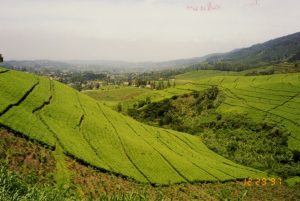
Tea farming on steeper lands in Java, Plastic bags frighten birds from eating the rice, Photos by Candy Riggins 1998.
As in Bali, rice paddies filled every small piece of land between the ramshackle dwellings. Plastic shopping bags mounted on sticks and scarecrows hopefully ward away birds trying to feed on ripe grain. With good protection from the sun, people labored over their tiny fields. No one seemed to notice the two taxis as they wandered through with their awestruck passengers, seeking an escape from this strange world of poverty.
At last, it was decided! Back to the Jakarta Sheridan which we had long ago passed up on the way from the airport. Having already had considerable cultural exposure that day, I gave in to popular demand and we went into retreat from that other world and hid out amidst the air-conditioned rooms, king-sized beds, saunas, hot tubs, cold tubs, steam rooms, weightlifting rooms, swimming pools, billiard tables, and western style restaurants and bars. We could have been in any big city in America, but we enjoyed it! Surprisingly, the cost of the three rooms and meals for six people for one night came to only $220!
Not wanting a repeat of Bali, I insisted on seeing some of the more rural countryside of Java. I arranged for a minibus to drive up in the mountains past Bogor and east to Bandung where we saw a slightly active volcanic landscape with a smoldering craters and hot springs. It was an all-day trip in heavy traffic as we experienced high speed freeways around Jakarta and winding mountain two lane roads with occasional road signs that said an “! “indicating a dangerous curve! Rice cultivation gave way to tea groves after a certain elevation and touristic towns lined the road. It was an exhausting day that ended with boarding the night flight back to Jaya Pura.
Merepati Airlines does not put much attention to service, and I must say the night flight provided little reprieve for our fatigue. The small seats and forced disembarkation at four different stops did not allow for much rest. With little head room, it was hard to peer through the windows and cigarette smoking was challenging! We arrived in Jaya Pura at 9:30 AM and found our connecting charter with Vanair to return us to Vanimo and PNG. In Vanimo, while going through customs, the plane to Wewak left without us. Our angel, Philip Tjoeng again came to our rescue by arranging a charter flight to Wewak.
New Year’s Eve in Wewak at the Wind Jammer Hotel on the Beach was quiet. We enjoyed romping in the waves and a good meal, but it was beyond anyone’s endurance to stay up and see the arrival of the New Year! Air Guinea took us back to Lae on New Year’s Day and our odyssey was over.

